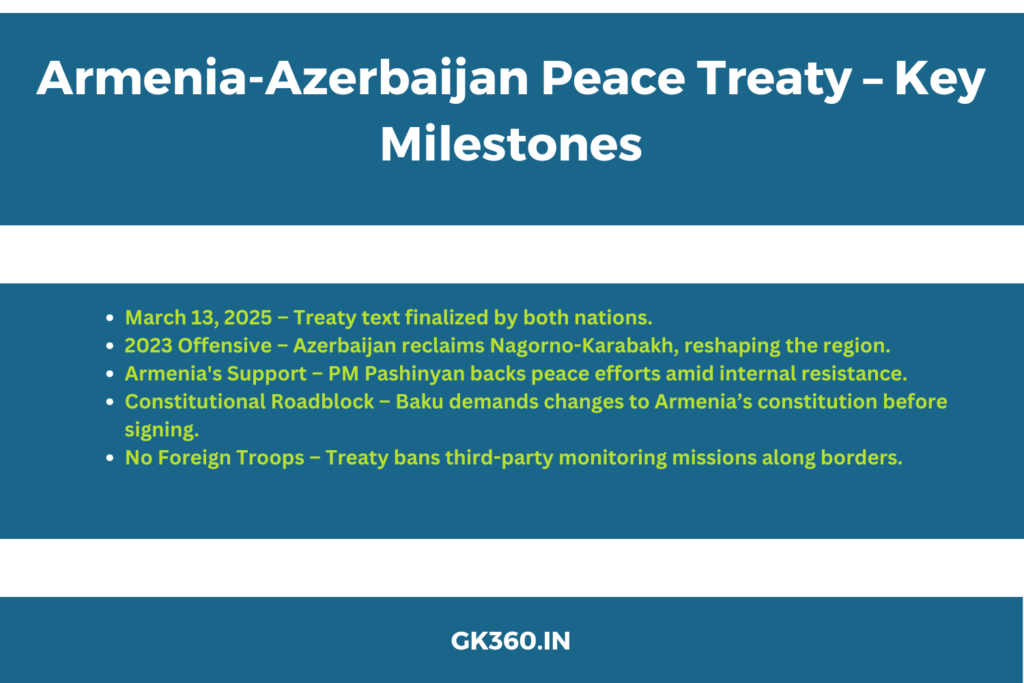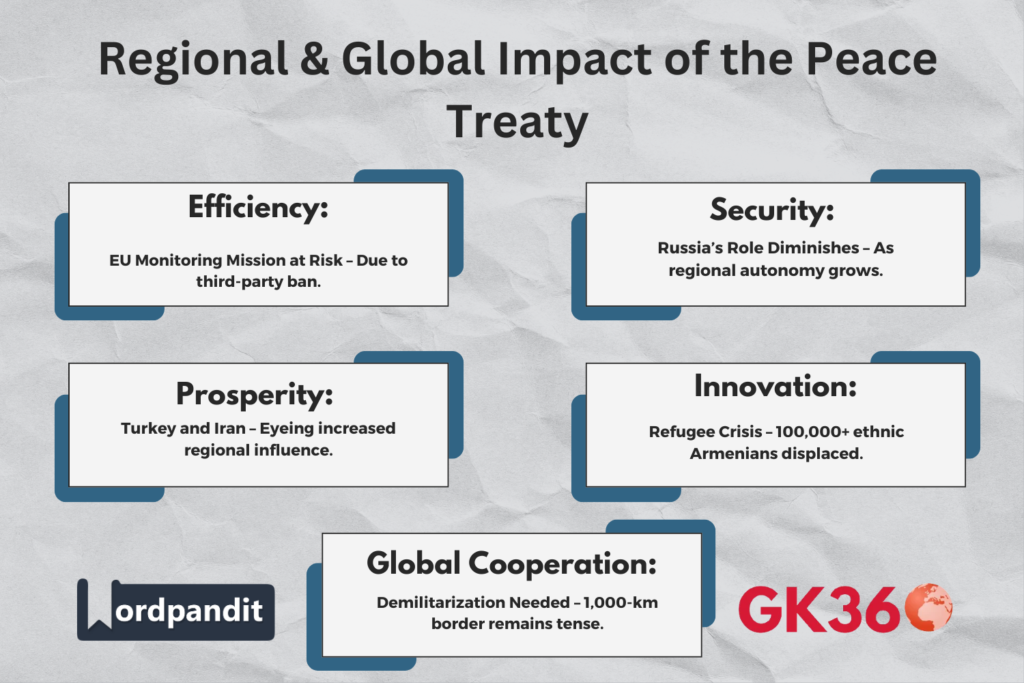Armenia-Azerbaijan Peace Treaty 2025: Final Text Agreed Amid Nagorno-Karabakh Tensions
Introduction: A Diplomatic Milestone
Armenia and Azerbaijan reached a pivotal milestone in their decades-long dispute over Nagorno-Karabakh—they officially agreed on the full text of a peace treaty. This marks a potential turning point in one of the world’s most entrenched and violent regional conflicts. The finalized text symbolizes a shared commitment to reconciliation and stability in the South Caucasus, although significant challenges remain before the treaty is formally signed.
With regional and international stakeholders closely watching, the treaty offers a rare glimpse of hope for a peaceful future. Yet, a key obstacle—the demand for constitutional changes in Armenia—remains unresolved, delaying the formal conclusion of the peace process.

Table of Contents
- Historical Background of the Nagorno-Karabakh Conflict
- The 2025 Peace Treaty: Key Provisions and Reactions
- The Constitutional Roadblock
- Global Implications and Regional Actors
- Lingering Tensions and Road to Stability
- Key Takeaways from the Peace Process
- FAQs
- Conclusion: Toward Lasting Peace in the South Caucasus
Historical Background of the Nagorno-Karabakh Conflict
The Nagorno-Karabakh conflict traces back to the late 1980s during the collapse of the Soviet Union. The region, though geographically within Azerbaijan, was predominantly inhabited by ethnic Armenians, who sought to secede and unify with Armenia. This sparked a violent territorial war, leading to ethnic cleansing, displacement, and massive casualties.
Key Events:
- First Nagorno-Karabakh War (1991–1994): Armenia-backed forces gained control over the region and several adjoining districts.
- Years of Stalemate: Despite ceasefires, hostilities simmered and occasional flare-ups occurred.
- September 2023 Offensive: Azerbaijan launched a swift military campaign, reclaiming the region in under 48 hours, prompting the exodus of over 100,000 ethnic Armenians to Armenia.
This offensive reset the geopolitical landscape, placing Nagorno-Karabakh fully under Azerbaijani control for the first time in decades and reigniting diplomatic efforts for a permanent peace.
The 2025 Peace Treaty: Key Provisions and Reactions
Armenia’s Position
On March 13, 2025, Armenia’s Ministry of Foreign Affairs declared the peace treaty text finalized and proposed consultations on when and where to officially sign it. This move underscores Armenia’s willingness to move forward, despite internal political and public resistance stemming from the recent loss of the Nagorno-Karabakh region.
Prime Minister Nikol Pashinyan has openly supported the peace initiative, portraying it as essential to ending hostilities and ushering in a new era of economic development and regional cooperation.
Azerbaijan’s Stance
Azerbaijan’s Foreign Ministry welcomed the treaty’s finalization, calling it a “historic step forward.” However, President Ilham Aliyev has made it clear that constitutional amendments in Armenia are a precondition for signing. Baku argues that Armenia’s current constitution includes indirect territorial claims, particularly references to Nagorno-Karabakh, which contradict the treaty’s terms.
The Constitutional Roadblock
Although the peace treaty text has been finalized, its formal signing remains uncertain due to Azerbaijan’s demand for constitutional reforms in Armenia. Azerbaijani officials insist that Armenia’s current constitution includes indirect claims on Azerbaijani territory, specifically references to Nagorno-Karabakh, which they argue are inconsistent with the treaty’s intent.
While Armenia denies making any explicit claims, Prime Minister Nikol Pashinyan has acknowledged the need for constitutional reform to facilitate long-term peace. However, he has stated that any replacement of the constitution would require a national referendum, a process that could take months and faces potential resistance at home.
This demand adds a significant layer of complexity, highlighting the fragile trust between the two nations and illustrating how domestic politics can delay international diplomacy.
Global Implications and Regional Actors
The Armenia-Azerbaijan peace deal also carries major geopolitical ramifications, particularly concerning the role of foreign forces and monitoring missions in the region.
Key Treaty Clause:
No third-party military or monitoring missions will be allowed along the Armenia-Azerbaijan border.
Impact on Foreign Stakeholders:
- European Union: The EU’s civilian monitoring mission in Armenia, deployed in early 2023, faces uncertainty. Baku has repeatedly opposed this presence, viewing it as an infringement on regional sovereignty.
- Russia: Russian border guards stationed along Armenian checkpoints may also be impacted. Given Russia’s traditional role as a regional peacekeeper, the exclusion of third-party forces signals a shift toward regional autonomy.
- Turkey and Iran: Both nations, deeply invested in South Caucasus affairs, have shown support for reduced Western influence but may also compete for increased regional leverage.
This clause reflects Azerbaijan’s desire for border sovereignty and signals a broader realignment of power in the post-Soviet South Caucasus.
Lingering Tensions and Road to Stability
Despite the diplomatic progress, tensions remain high and volatile. In January 2025, President Aliyev made inflammatory remarks, accusing Armenia of posing a “fascist threat”—rhetoric that rekindles old animosities and undercuts peacebuilding efforts.
Ongoing Challenges:
- Demilitarization: The two nations must now address the 1,000-km shared border, which remains heavily fortified and volatile.
- Refugee Crisis: Over 100,000 displaced ethnic Armenians remain in Armenia, facing uncertainty about repatriation or integration.
- Trust Deficit: Years of war, displacement, and nationalist rhetoric have left deep scars in both societies.
The path to lasting peace will require more than treaty text—it will need sustained political will, public reconciliation, and international support for reconstruction and dialogue.
Key Takeaways from the Peace Process
- Nagorno-Karabakh: Now fully under Azerbaijani control following the 2023 offensive.
- Treaty Roadblock: Azerbaijan demands constitutional amendments from Armenia before signing.
- Geopolitical Shift: Treaty bans foreign missions on borders, challenging EU and Russian roles.
- Future Outlook: Peace is within reach, but contingent on legal, political, and humanitarian resolutions.

Frequently Asked Questions (FAQs)
1. What is the current status of the Armenia-Azerbaijan peace treaty?
The treaty text is finalized, but signing is delayed due to Azerbaijan’s demand for Armenia to amend its constitution.
2. Why is Nagorno-Karabakh important in this conflict?
Nagorno-Karabakh is a disputed region with a majority ethnic Armenian population but internationally recognized as part of Azerbaijan. It has been the epicenter of decades of conflict.
3. What happened in the 2023 military offensive?
Azerbaijan launched a rapid military campaign in September 2023 and regained full control of Nagorno-Karabakh, prompting a large-scale exodus of ethnic Armenians.
4. Why does Azerbaijan oppose foreign monitoring missions?
Azerbaijan views such missions—particularly from the EU—as infringing on its sovereignty and prefers regional solutions without Western or Russian involvement.
5. What are the next steps for peace?
Key steps include constitutional reforms in Armenia, demilitarization of the border, refugee resettlement, and long-term trust-building between the nations.
Conclusion: Toward Lasting Peace in the South Caucasus
The finalization of the Armenia-Azerbaijan peace treaty text marks a monumental development in resolving one of the world’s most enduring and emotionally charged territorial conflicts. For over three decades, the Nagorno-Karabakh dispute has defined regional tensions, displaced communities, and shaped the political landscapes of both countries. This moment represents not just a diplomatic breakthrough, but also a turning point for generations that have only known war, uncertainty, and division.
Yet, peace on paper is only the beginning. The true test lies in its implementation. The road ahead is fraught with challenges—constitutional amendments in Armenia, public skepticism, and geopolitical friction—but these are not insurmountable. The treaty provides a blueprint for peaceful coexistence, grounded in mutual recognition of sovereignty and the aspiration for a better, more stable future.
If successfully signed and honored, this agreement could reshape the South Caucasus into a region of collaboration rather than confrontation. It offers the potential to spark economic development, foster cross-border connectivity, and elevate the region’s role in global diplomacy. Moreover, it could serve as a case study in conflict resolution, showing that even deeply entrenched disputes can be resolved through persistence, compromise, and visionary leadership.
Key Takeaways Table
| Aspect | Details |
| Treaty Finalization Date | March 13, 2025 – Armenia and Azerbaijan agreed on the peace treaty text. |
| Nagorno-Karabakh Status | Fully under Azerbaijani control after the 2023 offensive. |
| Constitutional Obstacle | Azerbaijan demands Armenia revise its constitution before treaty signing. |
| Geopolitical Clause | Treaty bans foreign military or monitoring missions on the shared border. |
| Refugee Impact | Over 100,000 ethnic Armenians displaced to Armenia post-2023 offensive. |
| Border Demilitarization Need | The 1,000-km shared border remains heavily fortified and unstable. |
| Global Power Shift | EU and Russia’s roles diminish; Turkey and Iran gain leverage. |





